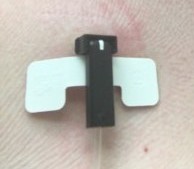A number of medications can induce mast cell degranulation and histamine release. Other medications increase the risk of anaphylaxis and can increase the severity of anaphylaxis.
Medication reaction profile is very individual and not all mast cell patients react to the medications listed below. Additionally, there may be a need for some mast cell patients to take medications listed below if the benefit outweighs the risk.
Patients on beta blockers are more likely to experience anaphylaxis and more likely for that anaphylaxis to be severe and treatment resistant. Beta blockers also impede treatment of anaphylaxis by interfering with the action of epinephrine[xvi]. Patients at risk for anaphylaxis who are on beta blockers should get a glucagon pen to use prior to epinephrine[xv].
| Beta adrenergic blockers[xvi] (Note: List is not exhaustive) |
| Acebutolol |
Atenolol |
Betaxolol |
Bisoprolol |
| Bucindolol |
Butaxamine |
Cartelol |
Carvedilol |
| Celiprolol |
Esmolol |
Metoprolol |
Nadolol |
| Nebivolol |
Oxprenolol |
Penbutolol |
Pindolol |
| Propranolol |
Sotalol |
Timolol |
|
Alpha blockers impede treatment of anaphylaxis by interfering with the action of epinephrine[xvii].
| Alpha-1 adrenergic blockers[xvii] (Note: List is not exhaustive) |
| Alfuzosin |
Amitryptiline |
Amoxapine |
Atiprosin |
| Carvedilol |
Chlorpromazine |
Clomipramine |
Clozapine |
| Dapiprazole |
Dihydroergotamine |
Doxazosin |
Doxepin |
| Ergotamine |
Etoperidone |
Fluphenazine |
Hydroxyzine |
| Imipramine |
Labetalol |
Loxapine |
Mianserin |
| Nefazodone |
Olanzapine |
Phentolamine |
Prazosin |
| Quetiapine |
Risperidone |
Silodosin |
Tamsulosin |
| Thimipramine |
Thioridazine |
Trazodone |
|
| Alpha-2 adrenergic blockers[xvii] (Note: List is not exhaustive) |
| Buspirone |
Chlorpromazine |
Clozapine |
Esmirtazapine |
| Fluophenazine |
Idazoxan |
Loxapine |
Lurasidone |
| Mianserin |
Mirtazapine |
Olanzapine |
Phentolamine |
| Risperidone |
Thioridazine |
Yohimbe |
|
Patients on angiotensin-converting enzyme (ACE) inhibitors are also more likely to experience anaphylaxis and more likely for that anaphylaxis to be severe and treatment resistant. The exact reason for this is unclear but ACE inhibitors impede appropriate bradykinin metabolism which may contribute to anaphylaxis[xvi].
| Angiotensin converting enzyme (ACE) inhibitors[xvi] (Note: List is not exhaustive) |
| Benazopril |
Captopril |
Enalapril |
Fosinopril |
| Lisinopril |
Moexipril |
Perindopril |
Quinapril |
| Ramipril |
Trandolopril |
|
|
Special notes:
Aspirin use in mast cell patients to suppress prostaglandin production is becoming increasingly common[xviii]. In some situations, other NSAIDs are also used.
Fentanyl, sufentanil, remifentanil and alfentanil are the preferred opioids for mast cell patientsiv. Hydromorphone releases minimal histamine and is also used in mast cell patients.[xix]
References:
[i] Valent P. (2014). Risk factors and management of severe life-threatening anaphylaxis in patients with clonal mast cell disorders. Clinical & Experimental Allergy, 44, 914-920.
[ii] Lange M, et al. (2012). Mastocytosis in children and adults: clinical disease heterogeneity. Arch Med Sci, 8(3), 533-541.
[iii] Dewachter P, et al. (2014). Perioperative management of patients with mastocytosis. Anesthesiology, 120, 753-759.
[iv] Eggleston ST, Lush LW. (1996). Understanding allergic reactions to local anesthetics. Ann Pharmacother, 30(7-8), 851-857.
[v] Brockow K, Bonadonna P. (2012). Drug allergy in mast cell disease. Curr Opin Allergy Clin Immunol, 12, 354-360.
[vi] Kwa A, et al. (2014). Polymyxin B: similarities to and differences from colistin (polymyxin E). Expert Review of Anti-infective Therapy, 5(5), 811-821.
[vii] Kun T, Jakubowski L. (2012). Pol J Radiol, 77(3), 19-24.
[viii] Blunk JA, et al. (2004). Opioid-induced mast cell activation and vascular responses is not mediated by mu-opioid receptors: an in vivo microdialysis study in human skin. Anesth Analq, 98(2), 364-370.
[ix] Toyoguchi T, et al. (2000). Histamine release induced by antimicrobial agents and effects of antimicrobial agents on vancomycin-induced histamine release from rat peritoneal mast cells. Pharm Pharmacol, 52(3), 327-331.
[x] Grosman N. (2007). Comparison of the influence of NSAIDs with different COX-selectivity on histamine release from mast cells isolated from naïve and sensitized rats. International Immunopharmacology, 7(4), 532-540.
[xi] Powell JR, Shamel LB. (1979). Interaction of imidazoline alpha-adrenergic receptor antagonists with histamine receptors. J Cardiovasc Pharmacol, 1(6), 633-640.
[xii] Muroi N, et al. (1991). Effect of reserpine on histamine metabolism in the muse brain. J Pharmacol Exp Ther, 256(3), 967-972.
[xiii] Sadleir PH, et al. (2013). Anaphylaxis to neuromuscular blocking drugs : incidence and cross-reactivity in Western Australia from 2002 to 2011. Br J Anaesth, 110(6), 981-987.
[xiv] Sanchez-Borges M, et al. (2013). Hypersensitivity reactions to non beta-lactam antimicrobial agents, a statement of the WAO special committee on drug allergy. World Allergy Organization Journal, 6(18), doi:10.1186/1939-4551-6-18
[xv] Thomas M, Crawford I. (2005). Glucagon infusion in refractory anaphylactic shock in patients on beta-blockers. Emerg Med J, 22(4), 272-273.
[xvi] Lieberman P, Simons FER. (2015). Anaphylaxis and cardiovascular disease: therapeutic dilemmas. Clinical & Experimental Allergy, 45, 1288-1295.
[xvii] Higuchi H, et al.(2014). Hemodynamic changes by drug interaction of adrenaline with chlorpromazine. Anesth Prog, 61(4), 150-154.
[xviii] Cardet JC, et al. (2013). Immunology and clinical manifestations of non-clonal mast cell activation syndrome. Curr Allergy Asthma Rep, 13(1), 10-18.
[xix] Guedes AG, et al. (2007). Comparison of plasma histamine levels after intravenous administration of hydromorphone and morphine in dogs. J Vet Pharmacol Ther, 30(6), 516-522.


